I’m so pleased Samantha Childress, who writes
is taking us to Vienna this week via a wonderful Guest Post for Time Travel Kitchen. Thank you, Sam! I’ll be back on Tuesday, see you then. JoleneMy husband and I had an itch to get in the holiday spirit early this season, so over Thanksgiving weekend, we took a quick trip from Cairo to Vienna to visit the Christmas markets, which for centuries have been a fixture in the city’s plazas and alleyways during Advent. After a year of living under the ever-present Egyptian sun, we couldn’t wait to feel a nip of cold, to watch string lights sparkle in late afternoon darkness, to stroll past stalls of red and green decorations while sipping hot drinks. Yet I was most excited to sample the markets’ famous street foods.
I set out to consume everything in sight not only because I adore snacks, but because I am a contrarian, and I secretly wanted to find fault in the Austrian capital’s cooking.
Vienna seems to garner unqualified praise from my fellow travelers, and to the Viennese themselves, everything is better in Vienna—the music is more moving, the parks more lush, the architecture more stately, and of course, the food tastier and more refined. A friend of mine who regularly evangelizes about the city even gushed that the cuisine is better than it is in Paris.
I find the constant accolades and self-congratulation annoying, and was determined to disprove it all. I would taste everything, I thought, and find conclusive evidence that Viennese gastronomy was nothing noteworthy.
Reader, I found no such proof. I grabbed every edible thing in sight, and it was all not only delicious, but comforting and fortifying. Viennese cuisine is a mishmash of delights from all over the former Austro-Hungarian Empire, the type of robust Central European fare that is perfect for a frosty winter’s day. I recount my favorite eats below, but the true breakout star of the holiday markets was a beverage: the hot, alcoholic Weihnachtspunsch (Christmas punch), which comes in a wide variety of flavors that warm you from the inside out. Skip to the bottom for a Christmas punch recipe—it’s the taste of the holiday markets in a mug.
Knödel
Our first stop was the market in front of Schönbrunn Palace, the summer residence of the Habsburgs (including the legendary Empress Sisi—if you haven’t yet watched The Empress on Netflix, I highly recommend it!). It was rainy and freezing when we arrived and our fingers were quickly turning to ice, so we grabbed mugs of steaming hot punsch and set out to look for a warm bite to eat. After one lap around the courtyard and peering into market stalls full of pretzels, roasted chestnuts, and fine pastries, these knödel—dumplings—looked most enticing.
Dumplings are a staple of Austrian cuisine, and come in a wide variety of doughs and fillings. These are selchfleischknödel, boiled potato dough filled with smoked minced pork and served hot on a bed of sauerkraut and fried onions. They were pillowy and hearty, and the onions gave the dish just the right amount of crunch. After scarfing these, we were once again ready to face the wintry afternoon.
Käsekrainer
Every now and then while traveling, I encounter a food whose lack of popularity in the U.S. absolutely blows my mind. To name a few: Japanese curry with fried katsuchicken, the delightfully pink Lyonnais tarte aux pralines, Moroccan beghrir pancakes served with delicate orange blossom syrup…but I digress.
Käsekrainer—a pork sausage stuffed with cheese, usually Emmental, and served in a toasted hot dog bun for portability—is now on that list. Käsekrainer’s cheesy, meaty, juicy goodness would be right at home at an American state fair, and it might be the best thing I ate all weekend. I searched for this little beauty for days before finally tracking it down at a stall in the enormous market in front of Vienna’s historic city hall. My husband and I had to fight our way through a throng of people pleasantly buzzed on Christmas punsch to get it, but it was worth it. I honestly wish we hadn’t split one in an attempt to save room to try other snacks, because having to share something so delicious was just sad.
Lángos
This flatbread is my platonic ideal of street food. It’s salty and cheesy; the dough is fluffy inside, yet has a firm enough crust to be handheld; and it’s served piping hot, straight from the deep fryer.
According to legend, lángos were invented by Hungarian villagers who made their bread in communal wood-fired ovens. They would cut off small scraps of dough just before putting a large batch over the flame, then bake the scraps at home for a quick breakfast. Those baked bread scraps evolved into today’s deep-fried and garnished version. The traditional toppings are garlic oil, sauerrahm (sour cream), and cheese, but meat and onions are also common—we even had a pizza version at the market woven into the narrow alleys of artsy, bohemian Spittelberg.
We loved our lángos so much we tried recreating the flatbreads at home. While the dough we had in Vienna was fairly salty and savory, this recipe yielded a neutral base that worked for both dinner and dessert, and it was surprisingly easy to make.1 We had the traditional toppings of garlicky olive oil, sour cream (we actually cheated and used labneh, which is easier to find in Cairo!) and cheese for our main dish, then we slapped on some Nutella for a sweet treat at the end of the meal.
Weihnachtspunsch
No trip to a Viennese Christmas market could be complete without a mug of Weihnachtspunsch. Naturally, we had many. The best part is that the punch is always served in ceramic souvenir mugs that you can either keep or return when you’re finished to get some of your money back. From what I can tell, there isn’t one “traditional” Christmas punch recipe, but rather a few staple varieties you tend to see at each market—like orange, berry, alcohol-free kinderpunsch for children—that the bartenders at individual punch stands might riff off of. Orange chili was our favorite, so much so that my husband reverse-engineered it at home. His recipe is below.
A few notes on this recipe: Many varieties of Christmas punch use red wine as a base. This recipe doesn’t, because I’m allergic to wine (I know, it’s one of my life’s great tragedies). We used hibiscus tea to get a similar full-bodied mouthfeel to red wine, but if you’d prefer to use wine, you could easily do that instead. Just be sure to reduce the Grand Marnier a bit…or don’t, if you really want to party. And if you’re feeling lazy but still want a taste of the Christmas market experience, you can always throw a dash of rum in hot chocolate with plenty of whipped cream—that is just as authentically Viennese as any Weihnachtspunsch. Enjoy!
Sam and Nick’s Orange-Chili Christmas Punsch Recipe
Ingredients
3 tbsp (5 grams) hibiscus tea (either dried flowers or tea bags should work fine)
1 cinnamon stick
1 star anise pod
2 cloves
1 hot red pepper
3/4 cup pulp-free orange juice (about 3 oranges, if you’re juicing your own)
1 tbsp white sugar
2-3 shots Grand Marnier
Instructions
Boil 1.5 cups water. Turn off stove.
Steep the hibiscus, cinnamon, star anise, cloves, and pepper for 10 minutes.
If you are using fresh oranges, juice them while the tea and spices are steeping and strain out the pulp.
Once the tea and spices have steeped for 10 minutes, add the orange juice and sugar, then re-simmer.
Add 2-3 shots Grand Marnier to taste and pour into mugs to enjoy immediately. Serves two.
1 Note: the recipe we used does not contain potato. Apparently this is controversial. If I had to guess, I’d put my money on the version we ate in Vienna not containing potato, either, but potato is a common and traditional ingredient in lángos dough.
Thanks, everyone — have a great weekend!

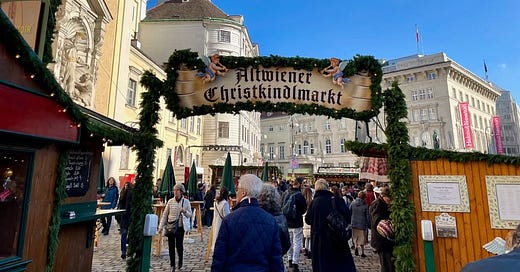



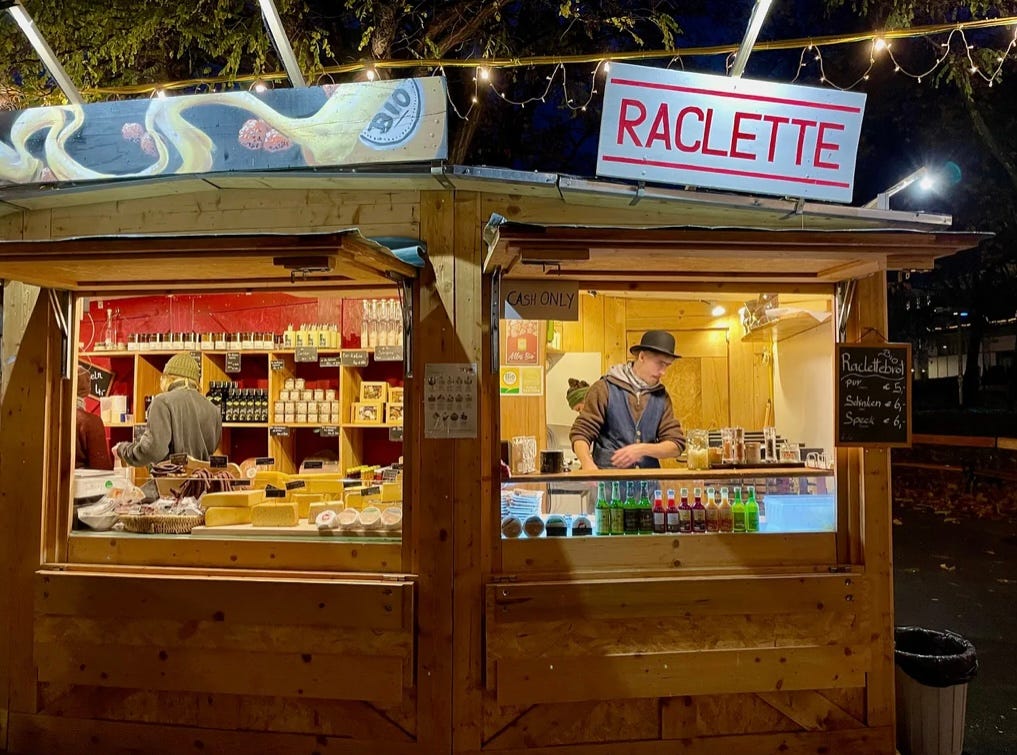
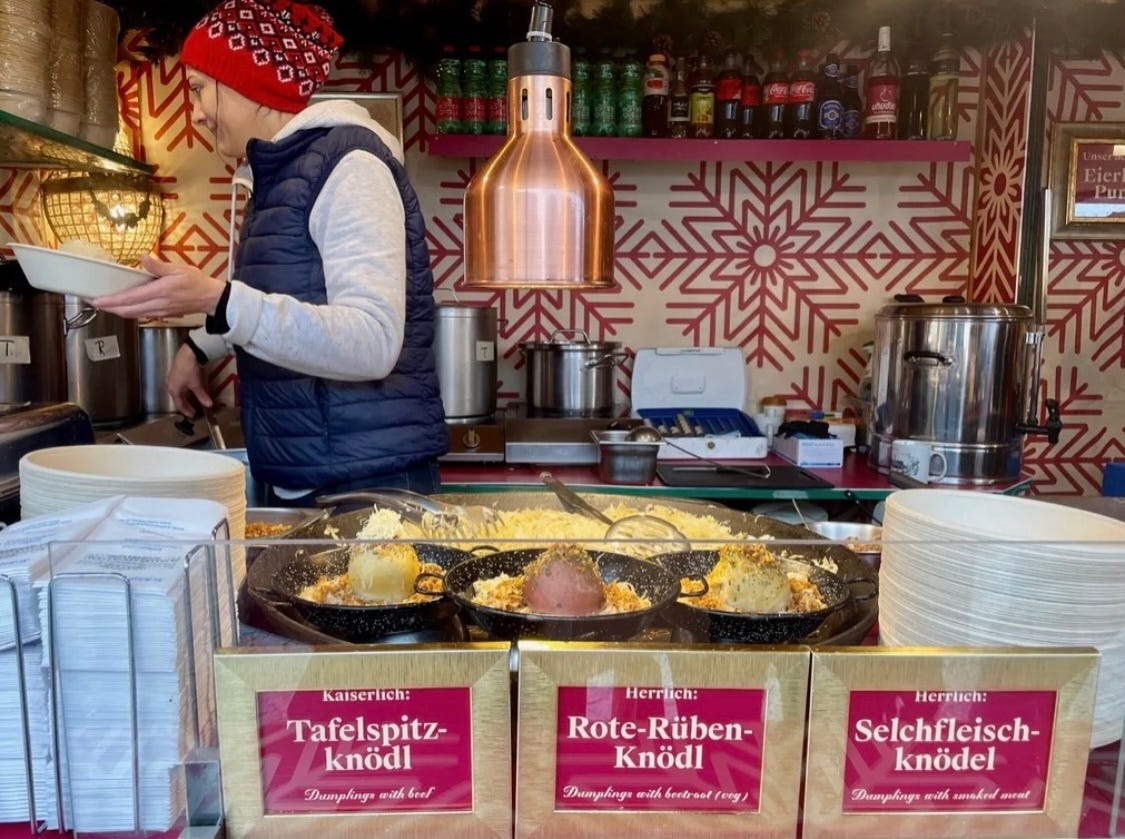
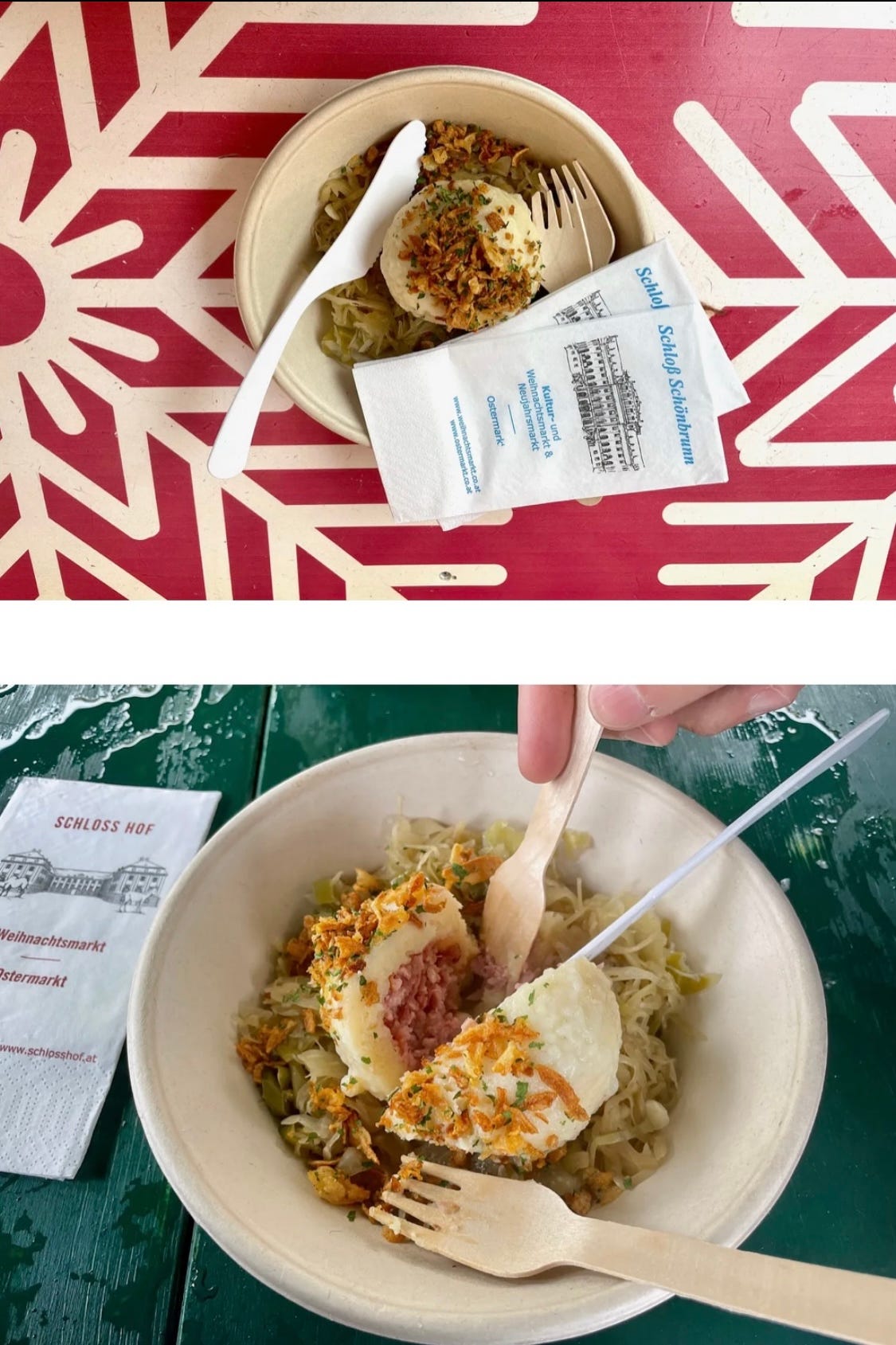

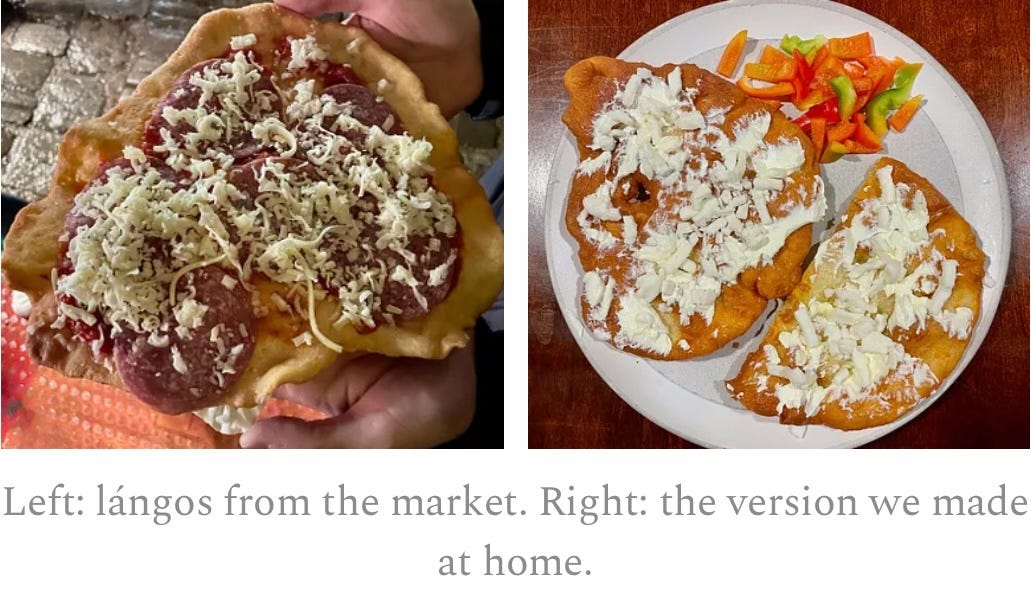
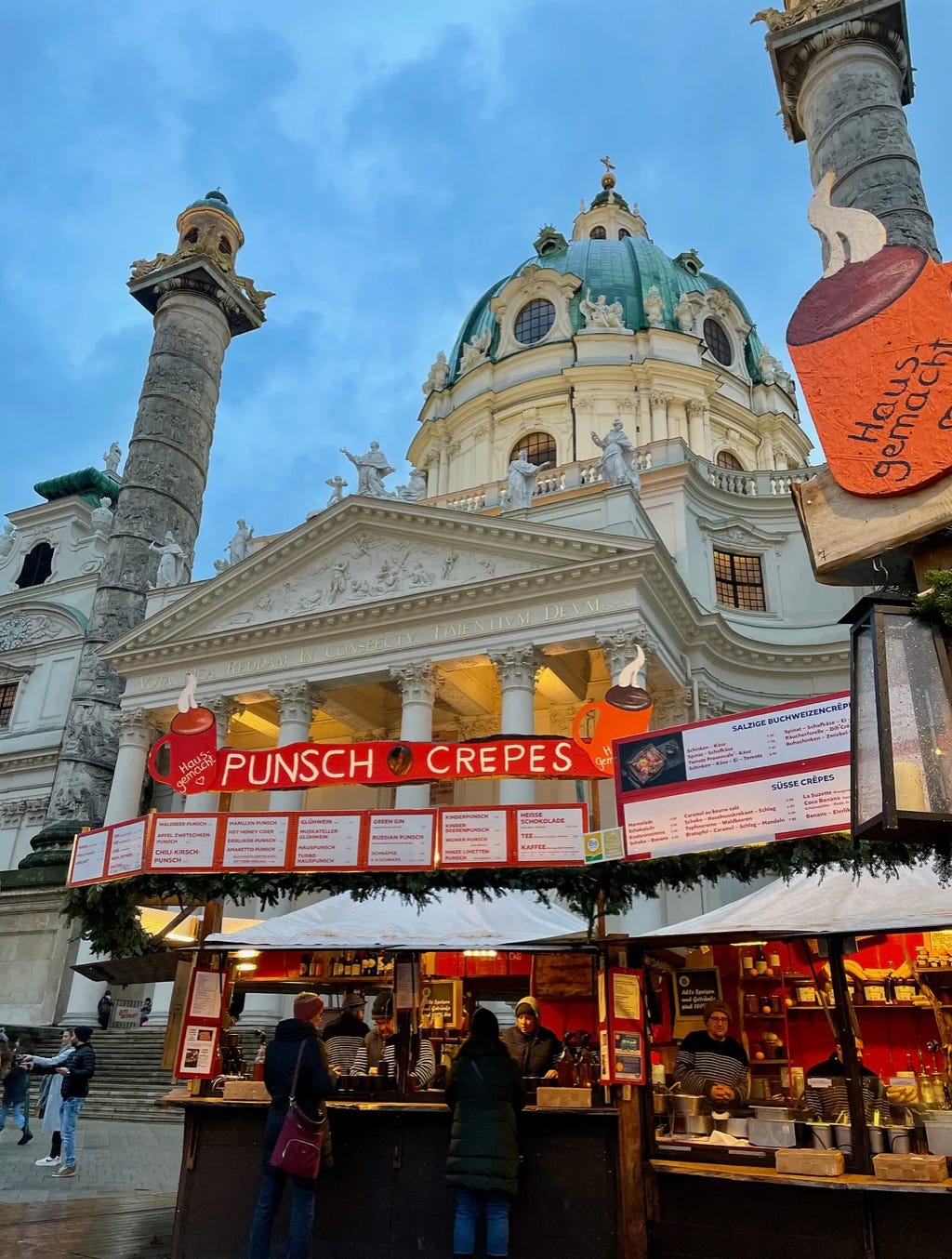
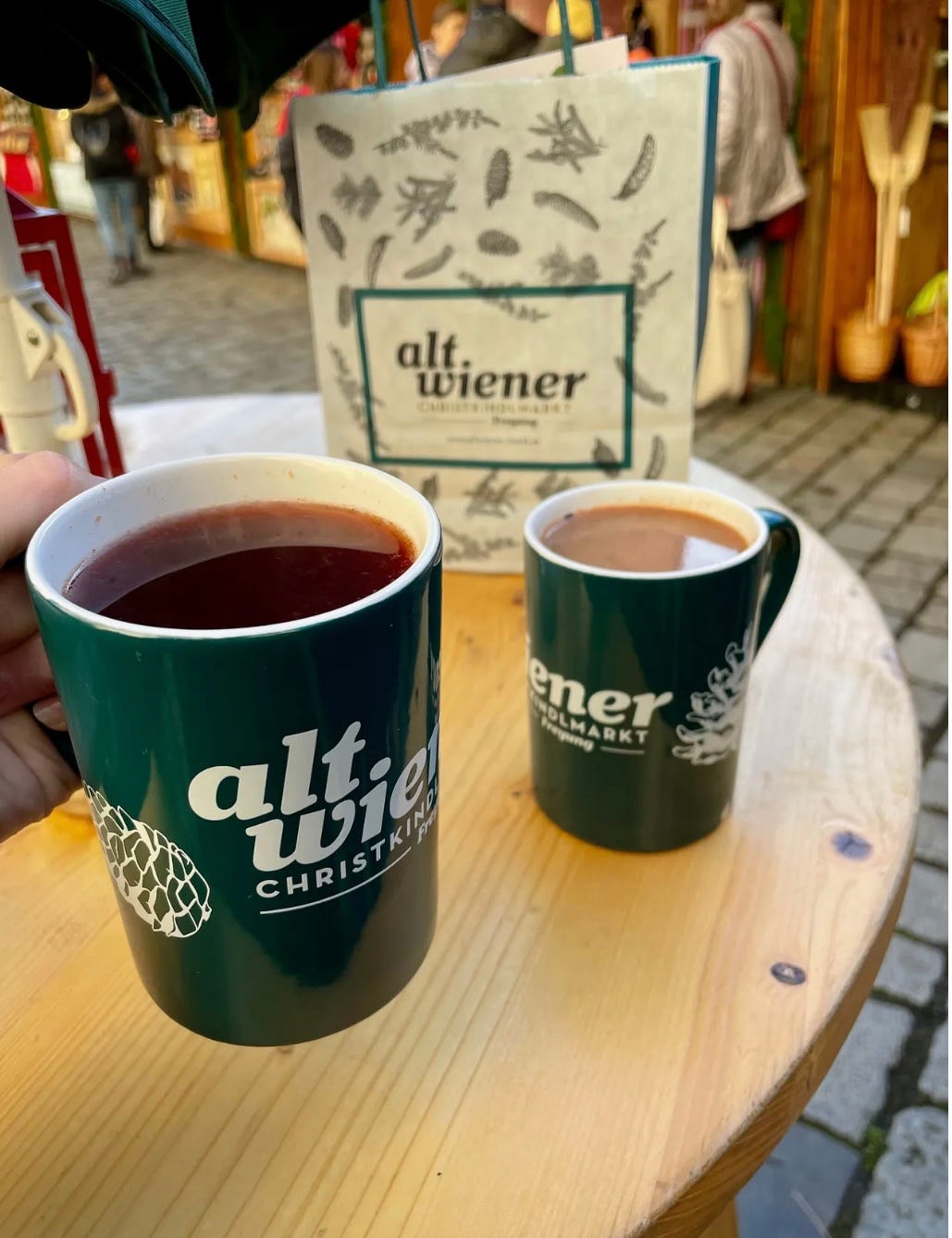

Thank you, Sam! Great ‘traveling’ with you and now I’m hungry! 😆❤️
Charming! I bookmarked the langos.